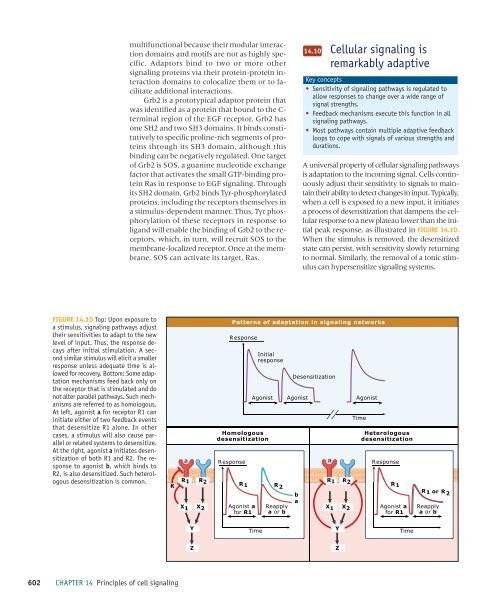Principles of cell signaling - UT Southwestern
Principles of cell signaling - UT Southwestern
Principles of cell signaling - UT Southwestern
Create successful ePaper yourself
Turn your PDF publications into a flip-book with our unique Google optimized e-Paper software.
39057_ch14_<strong>cell</strong>bio.qxd 8/28/06 5:11 PM Page 602<br />
multifunctional because their modular interaction<br />
domains and motifs are not as highly specific.<br />
Adaptors bind to two or more other<br />
<strong>signaling</strong> proteins via their protein-protein interaction<br />
domains to colocalize them or to facilitate<br />
additional interactions.<br />
Grb2 is a prototypical adaptor protein that<br />
was identified as a protein that bound to the C-<br />
terminal region <strong>of</strong> the EGF receptor. Grb2 has<br />
one SH2 and two SH3 domains. It binds constitutively<br />
to specific proline-rich segments <strong>of</strong> proteins<br />
through its SH3 domain, although this<br />
binding can be negatively regulated. One target<br />
<strong>of</strong> Grb2 is SOS, a guanine nucleotide exchange<br />
factor that activates the small GTP-binding protein<br />
Ras in response to EGF <strong>signaling</strong>. Through<br />
its SH2 domain, Grb2 binds Tyr-phosphorylated<br />
proteins, including the receptors themselves in<br />
a stimulus-dependent manner. Thus, Tyr phosphorylation<br />
<strong>of</strong> these receptors in response to<br />
ligand will enable the binding <strong>of</strong> Grb2 to the receptors,<br />
which, in turn, will recruit SOS to the<br />
membrane-localized receptor. Once at the membrane,<br />
SOS can activate its target, Ras.<br />
14.10<br />
Cellular <strong>signaling</strong> is<br />
remarkably adaptive<br />
Key concepts<br />
• Sensitivity <strong>of</strong> <strong>signaling</strong> pathways is regulated to<br />
allow responses to change over a wide range <strong>of</strong><br />
signal strengths.<br />
• Feedback mechanisms execute this function in all<br />
<strong>signaling</strong> pathways.<br />
• Most pathways contain multiple adaptive feedback<br />
loops to cope with signals <strong>of</strong> various strengths and<br />
durations.<br />
A universal property <strong>of</strong> <strong>cell</strong>ular <strong>signaling</strong> pathways<br />
is adaptation to the incoming signal. Cells continuously<br />
adjust their sensitivity to signals to maintain<br />
their ability to detect changes in input. Typically,<br />
when a <strong>cell</strong> is exposed to a new input, it initiates<br />
a process <strong>of</strong> desensitization that dampens the <strong>cell</strong>ular<br />
response to a new plateau lower than the initial<br />
peak response, as illustrated in FIGURE 14.10.<br />
When the stimulus is removed, the desensitized<br />
state can persist, with sensitivity slowly returning<br />
to normal. Similarly, the removal <strong>of</strong> a tonic stimulus<br />
can hypersensitize <strong>signaling</strong> systems.<br />
FIGURE 14.10 Top: Upon exposure to<br />
a stimulus, <strong>signaling</strong> pathways adjust<br />
their sensitivities to adapt to the new<br />
level <strong>of</strong> input. Thus, the response decays<br />
after initial stimulation. A second<br />
similar stimulus will elicit a smaller<br />
response unless adequate time is allowed<br />
for recovery. Bottom: Some adaptation<br />
mechanisms feed back only on<br />
the receptor that is stimulated and do<br />
not alter parallel pathways. Such mechanisms<br />
are referred to as homologous.<br />
At left, agonist a for receptor R1 can<br />
initiate either <strong>of</strong> two feedback events<br />
that desensitize R1 alone. In other<br />
cases, a stimulus will also cause parallel<br />
or related systems to desensitize.<br />
At the right, agonist a initiates desensitization<br />
<strong>of</strong> both R1 and R2. The response<br />
to agonist b, which binds to<br />
R2, is also desensitized. Such heterologous<br />
desensitization is common.<br />
K<br />
a<br />
Homologous<br />
desensitization<br />
Initial<br />
response<br />
R1 R 2<br />
R1 R 2<br />
X 1 X 2<br />
R esponse<br />
Response<br />
Patterns <strong>of</strong> adaptation in <strong>signaling</strong> networks<br />
Agonist a<br />
for R1<br />
Agonist Agonist Agonist<br />
Reapply<br />
a or b<br />
Desensitization<br />
b<br />
a<br />
a<br />
R1 R 2<br />
X 1 X 2<br />
Time<br />
Heterologous<br />
desensitization<br />
Response<br />
R1<br />
Agonist a<br />
for R1<br />
or R1 R 2<br />
Reapply<br />
a or b<br />
Y<br />
Time<br />
Y<br />
Time<br />
Z<br />
Z<br />
602 CHAPTER 14 <strong>Principles</strong> <strong>of</strong> <strong>cell</strong> <strong>signaling</strong>
















